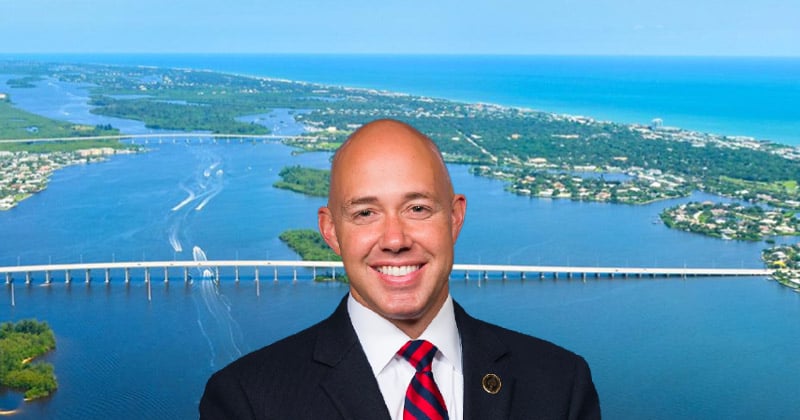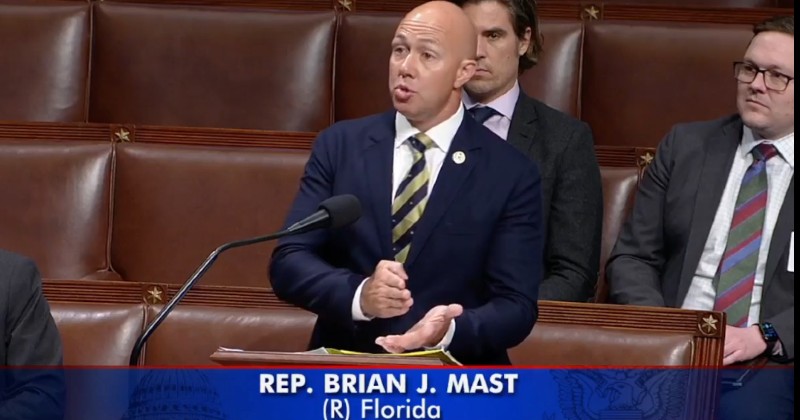This week, U.S. Rep. Brian Mast, R-Fla., advanced seven pieces of legislation to address water quality and water infrastructure needs in Florida as part of the “Water Resources Development Act.”
The biennial piece of legislation, which was passed by the U.S. House Transportation and Infrastructure Committee today, included Mast’s “Northern Estuaries Restoration Plan” which sends $100 million to construct infrastructure protecting the St. Lucie River, Indian River Lagoon and Lake Worth Lagoon, and five other provisions written by the congressman.
“Without a doubt, the number one issue for our community is water. With the Water Resources Development Act, we have the chance to move the ball down the field in that fight, and this year, we got substantially closer to our touchdown: no discharges ever again,” Mast said. “Included in the bill is the Northern Estuaries Restoration Plan, which is a landmark piece of legislation mandating the Army Corps develop the infrastructure needed to completely eliminate harmful discharges to the northern estuaries. On top of that, this bill includes $100 million that I secured for water quality improvement projects to benefit the St. Lucie River, Indian River Lagoon and Lake Worth Lagoon. This bill also includes 5 other provisions I wrote to improve water quality in the Indian River Lagoon, combat harmful algal blooms, remove legacy nutrients from Lake Okeechobee and more. Taken together, this bill is a massive win for the environment, public health and economy in our community.”
Included in the bill are seven major provisions written by Mast:
The Northern Estuaries Restoration Plan:
When the Comprehensive Everglades Restoration Plan (CERP) was authorized by Congress in 2000 to restore America’s Everglades, it was historic progress for Florida’s environment. While CERP projects are critically important, however, they will stop only about two-thirds of discharges to the St. Lucie Estuary.
The Northern Estuaries Restoration Plan (NERP) will take over where CERP leaves off. It will require the Army Corps to plan additional infrastructure to stop the remaining discharges that CERP won’t. Finishing construction on all CERP projects remains the immediate goal and this bill will ensure that the Army Corps does not wait until that is over to start work on additional infrastructure to fully eliminate discharges.
$100 Million to Protect Our Estuaries:
Water quality in the St. Lucie River, Indian River Lagoon and Lake Worth Lagoon has degraded substantially as a result of toxic discharges from Lake Okeechobee, as well as pollution from agricultural and municipal sources. Martin, St. Lucie and Palm Beach Counties have all been plagued by toxic algal blooms as a result, and public health is put at risk.
This provision will authorize $100 million in new funding for Martin, St. Lucie and Palm Beach Counties to build water infrastructure designed to improve water quality in the St. Lucie River, Indian River Lagoon and Lake Worth Lagoon. The funding is directed to be used for local water projects, such as septic to sewer conversions or construction of new waste and stormwater treatment infrastructure to improve water quality in the estuaries.
Improving Water Quality in the Indian River Lagoon:
The ongoing Indian River Lagoon – South (IRL-S) Project is a multi-billion dollar investment in one of the most biologically diverse estuarine systems in the continental United States. Unfortunately, this project is at risk of major delays due to inflation and other cost overruns. Congressional action is needed to ensure this project has enough funding to stay on track.
Mast wrote this provision to authorize the additional funding needed to keep the project on schedule. More information on this critical project is available here.
Developing New Technology to Combat Harmful Algal Blooms:
Previous iterations of WRDA have included provisions written by Rep. Mast to develop new technology to combat harmful algal blooms, primarily focusing the research and development efforts on the source of the blooms in Lake Okeechobee.
This year, Mast added a provision authorizing the Army Corps to develop new technology and tools to predict, detect, prevent, treat and eliminate harmful algal blooms specifically in the St. Lucie and Caloosahatchee.
Expediting Completion of the EAA Reservoir:
The Everglades Agricultural Area (EAA) Reservoir was authorized through a provision written by Rep. Mast in WRDA 2018, and in 2020, Mast secured language that clarified a “new start” designation was not needed for the Army Corps to begin construction. Despite the clarification of Congressional intent provided in the last iteration of WRDA, the Army Corps has failed to adequately prioritize this vital project.
WRDA 2022 includes report language written by Mast that requires the Army Corps to prioritize and expedite completion of the EAA Reservoir.
Removing Legacy Nutrients from Lake Okeechobee:
Phosphorus and nitrogen feed harmful algal blooms. Unfortunately, large quantities of these nutrients have accumulated in muck at the bottom of Lake Okeechobee. Even if ongoing pollution was completely eliminated, these legacy nutrients could continue to fuel harmful algal blooms for decades to come.
Mast’s amendment authorizes the dredging of legacy nutrients from Lake Okeechobee for environmental purposes, including the removal of excess phosphorus. Removing these legacy nutrients from the lake is critical in the fight to combat harmful algal blooms.
Defending Military Personnel from Harmful Algal Blooms:
Military personnel working on and around Lake Okeechobee are routinely exposed to harmful algal blooms, often for more than eight hours per day. These blooms regularly test above the level that the Environmental Protection Agency (EPA) has stated is dangerous to human health, increasing the risk of Alzheimer’s, ALS, liver disease and more. Often, the physical impacts of this exposure may not be evident for decades.
Mast’s amendment requires the Army Corps to note in the file of personnel every time that they are exposed to harmful algal blooms that exceed the level the EPA has determined to be unsafe. This tracking is critical to ensuring that personnel are able to receive the care and compensation necessary should they face these disastrous health impacts.
The Water Resources Development Act was passed by the House Transportation and Infrastructure Committee. The bill now awaits consideration by the full U.S. House.











